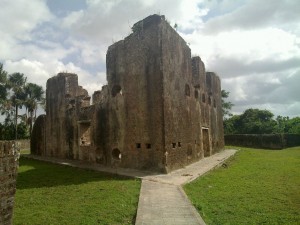
Ever thought about a romantic dinner at an old colonial fort in Guyana, filled with live entertainment and good conversations with friends and family, then here is the opportunity. The Tourism Ministry on Saturday will be hosting Fort Island Dinner and Show under the stars of the Essequibo River on Saturday, For only Gy$ 10,000, guests will enjoy live entertainment and lots of fun with special guest appearance and performance by Dave Martins and Friends.
“Nothing rivals the setting and uniqueness of a new dining experience; this exclusive epicurean event combines a generous serving of history and cuisine presented a stone’s throw away from the ruins of the historic Fort Zeelandia – join in Romancing the Fort,” the ministry said.
Almost-private dinner
The fort, which sits high atop a promontory on the grounds of Fort Island, dates to the 1800s, now, by night, it is the backdrop for an almost-private dinner under the stars – only a few tables will be set on the lawns of the Court of Policy amid native flora and stone remnants of the buildings that once protected the island from advancing marauders.
“It is a spectacular setting, looking out over a vast expanse of the Essequibo River, under a blanket of stars,” Tourism Minister Irfaan Ali opined.
The rocky bluff of the island with its wild vegetation complements the manicured grounds of the Court of Policy, resonating with history, a perfect setting for this inaugural event.
“Book this special dinner for Gy$ 10,000 per person (including return transportation and tours) and you’ll get to spend time amid the ruins with family and friends, soaking up the unique experience while making memories of your own,” the ministry said.
Tickets are available at the tourism and housing ministries and the Tourism and Hospitality Association of Guyana.
Those travelling to Fort Island for this special occasion will assemble at the Guyana National Stadium, Providence, East Bank Demerara at 14: 00h and will then depart for Parika to be whisked away for the five hour island experience; returning to Georgetown by midnight.
About Fort Zeelandia
Fort Zeelandia is located on Fort Island, a fluvial island of the Essequibo River delta in the Essequibo Islands-West Demerara region of Guyana. The current brick fort was built in 1743 for the Essequibo colony, replacing an earlier wooden fort built in 1726, and is among the oldest structures in Guyana. The fort replaced Fort Kyk-Over-Al as the capital of Essequibo in 1739.
From the beginning of the 18th century, the commanders of Essequibo recommended that the location of the colony’s administrative centre be removed as a result of the relocation of the Dutch settlers on the fertile banks of the Essequibo River.
In 1726, it was resolved that a fort should be constructed to protect the planters and the interest of the Dutch West India Company (DWIC). In 1726, Leslorant, an engineer was sent from the Netherlands to construct a horn work with wooden redoubt and a strong palisade of the northern point of Vlaggeneiland (Flag Island). In August 1738, Laurens Storms van Gravesande, the secretary to Commander Gleskerk, inspected the fort and reported that the structure was falling to pieces.
He recommended to the directors of the Netherlands that a new fort of brick be built to defend the interest of the DWIC. Construction of the fort commenced in 1740 and with the labour of enslaved Africans, the structure was completed in 1743. Brick was baked on the spot and mortar and trass were imported from Barbados and the Netherlands.
The entire complex was however completed in 1749 as construction was delayed as a result of the shortage of building material and labour. The completed structure was then christened Fort Zeelandia after the County of Zeeland in the Netherlands, from which many of the original settlers had originated.
The Lozenge shaped design of the fort, submitted by Gravesande, is similar to other forts constructed in West Africa during that period.
Fort Zeelandia consisted of a redoubt of 50 square feet, with walls thick enough to endure the heaviest ordnance.
There were two stories; the lower served as a warehouse for provisions and a safe powder house, while the upper floor housed the soldiers, with a room for the non- commissioned officers.
Twenty portholes, consisting of two and three pounders were found on each storey.



